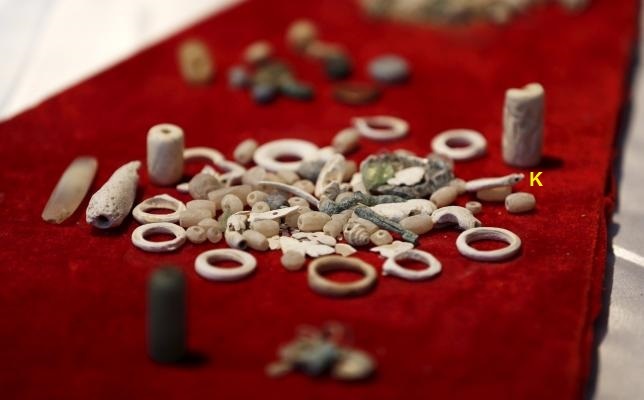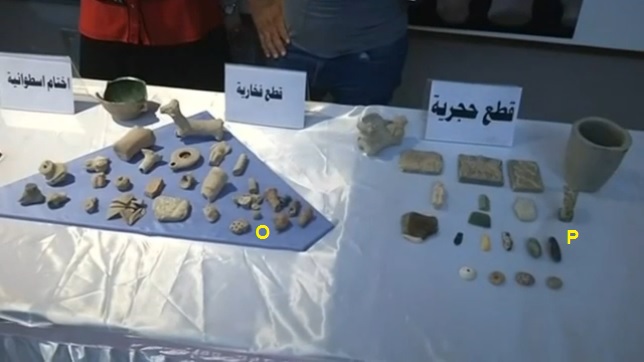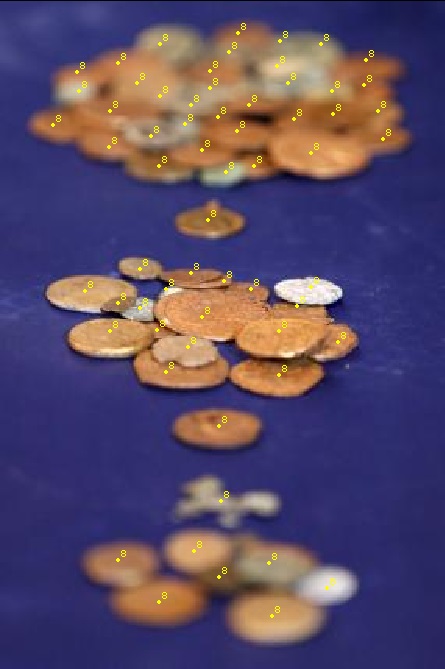Someone kindly prompted me to reconsider the balance of antiquities and fakes in Abu Sayyaf’s stash and I thought it might be worth trying to count some of the sets of objects on display. I didn’t want to do it before, because I don’t trust my eye for this material, but the fakes here appear to be so poor that they largely distinguish themselves.
I fear that unguided journalists’ professional effort to capture the variety of objects may have incidentally foregrounded the fakes, of which there is a far greater variety than there is of coins and beads. And archaeologists and criminologists (myself included), then, focused on the outliers instead of the the overwhelming majority of objects. It appears that most of Abu Sayyaf’s illicit antiquities were ancient coins.
[I’m working on a huge update based on the U.S. State Department Cultural Heritage Center’s summary and photo gallery of the ISIL leader’s loot.]
In this revision of my original post on ‘first material proof‘ that Islamic State is trafficking antiquities and my update-summarising follow-up post, I’ve drawn on photos and video frames from Amir Musawy, Thaier al-Sudani, Vivian Salama, Reuters and the Agence France-Presse (AFP). These aren’t all of the objects and I can’t see all of the objects in these images, but it’s a start.
In this video frame, I think that there are at least 176 coins: 16 (A); 30 (B); 26 (C, though I think that’s an under-count even of the visible ones); 22 coins (D, though that is definitely an under-count, as I cannot distinguish between the coins in the spilled stack); 24 coins (E, though the pile is partly off-camera); 6 coins (F); 38 coins (G, though the pile is partly off-camera); 3 (H); 4 (I); and 7 (J).

Kultur kommt zürück
(c) Amir Musawy, Mittagsmagazin, Das Erste, 15. Juli 2015
In this photograph, there are at least 86 assorted objects in the central group (K, excluding all of the out-of-focus objects in the foreground and background of the photo, even those that are individually distinguishable). I have recounted, using a tool that I explain below, and still found at least 86.

U.S. delivers Iraqi antiquities seized in raid on Islamic State
(c) Thaier al-Sudani, Reuters, 15th July 2015

Iraq receives artifacts found by US Special Forces in Syria
(c) Thaier al-Sudani, the Associated Press (AP), 15th July 2015 b via ImageJ
In this photograph, there are 1 vase (L, in maybe 24 fragments); 14 – forged? – bracelets (M); and 8 other assorted objects (N), at least some of which – such as the pair of mint condition metal bracelets – do not appear to be antiquities.

Iraq receives artifacts found by US Special Forces in Syria
(c) Vivian Salama, the Associated Press (AP), 15th July 2015
In this video frame, there are 36 assorted objects and fragments of objects (O); and 20 other assorted objects (P), at least some of which – such as the metal-smelting crucible – are not antiquities.
However, my brother – who works on medical technology and biomedical engineering – saw me laboriously adding numbers to an image in Paint and showed me how to use the Cell Counter plug-in to ImageJ. (It’s still manual, but it’s far quicker and easier and more aesthetically pleasing.) In just one photograph where three sets of coins were laid out individually, where a significant number of coins were out of shot, there were at least 173 early Islamic coins; in another, there were at least another 63; thus, in total, there were at least 236.
(For the avoidance of doubt, these may include sets that were shown in piles in the first photo.)
Considering the fact that coins were excluded or obscured in the photos of these sets, and that other sets of coins were excluded from these photos and not displayed individually elsewhere, the early Islamic coins alone must have constituted the majority of the antiquities in Abu Sayyaf’s stash.
Questions remain about which objects were accompanied by thirty-year-old sales receipts, whether the forgeries had been manufactured or knowingly acquired by Islamic State traffickers or whether they had been unthinkingly looted from institutional stores…
But these counts show that most of Abu Sayyaf’s stash consisted of genuine, highly-portable antiquities (which could have been transported both by the Islamic State and by U.S. commandos in one small container). Once these coins had been uploaded to eBay or VCoins or Facebook, or laid out in a dealership in Istanbul or London or New York, how would dealers and collectors have distinguished them from so many others?

Iraqi women stand next to some of the returned artefacts
(c) Agence France-Presse (AFP), the Australian, 16th July 2015


